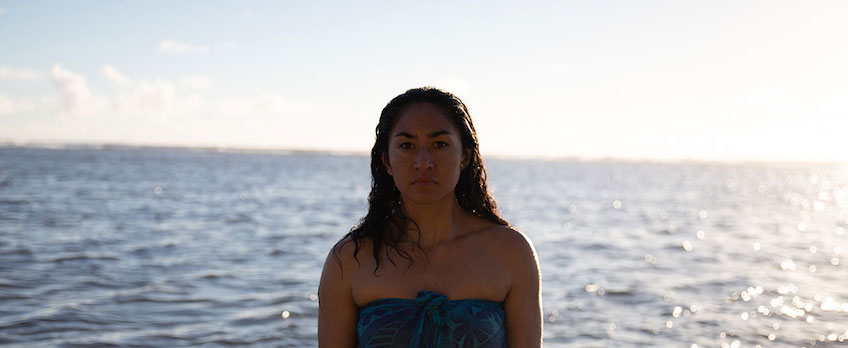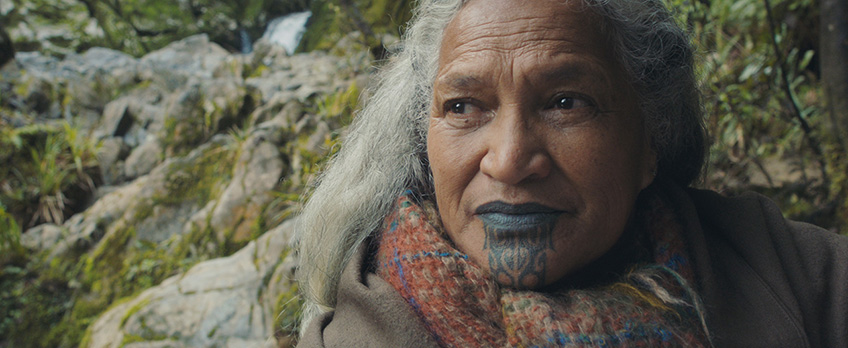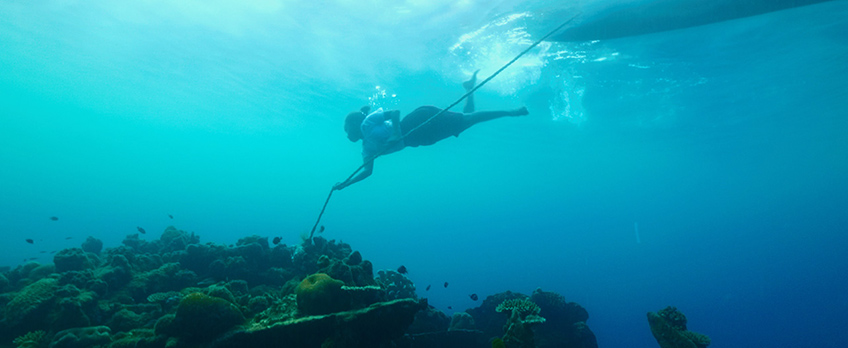Interested in writing for our blog? Send your pitches to editor@miff.com.au.
Eight Lives, One Ocean: Vai Celebrates the Staggering Resilience of Pasifika women

The portmanteau film Vai, which interweaves the personal stories of Pacific Islanders, is a delicate balancing act, punctuated by elegant transitions between the contemporary aftershocks of colonial history and the dizzying expanse of sea. Featuring eight vignettes directed by eight Pasifika women, the film paints a holistic portrait of womanhood. Although each story centres on a distinct woman, scattered from Fiji to Aotearoa, they are all nicknamed “Vai”: a word that means “water” in all of the Pacific languages.
Each Vai, arranged from youngest to the eldest, is aware of her namesake and the unifying importance of the sea – the filmmakers luxuriate in images of its heroines immersed in bodies of water and glancing outward at crashing tides, as they perform ceremonies and gather strength from their land.
Looming over the entire film is the spectre of colonialism. Several segments follow the way Western conquest has left Pacific communities ravaged by poverty; many of the film’s characters are forced to uproot themselves, moving to settler-colonial hubs for work and education. Meanwhile, others scramble and beg for clean drinking water. Two segments take aim at explicit organs of imperial might – Marina Aofagia McCartney’s “Samoa” shows the Christian church’s quashing of traditional practices, while Miria George’s “Kuki Airani” depicts the phenomenon of corporations bribing islanders into yielding to their over-fishing. Vais are united by their battle with institutional pressures and a steadfast love for their people; but they are also vibrant in their individuality, resisting the colonial view of the region as an exotic monolith.
Although some stories lack the boldness and originality of others, the film contains a strong sense of cohesion despite its potpourri of character voices, avoiding the disjunction that plagues many portmanteaus. Coherency of style is greatly assisted by cinematographer Drew Sturge’s saturated, tropical colours and abundant use of sunlight, which highlights the buoyancy and love the characters derive from their homes. The directors also uniformly sustain the effect of a single, unbroken shot, creating an immersive, episodic format where we feel anchored by the central heroine's movement through her space.

A scene from the portmanteau film Vai
This awareness of how characters relate to their surroundings is particularly evident in the bold, creatively staged stories at the start, which centre on vulnerable, mischievous young girls, who struggle with the tension between the lightness of their youth and the bleakness of their immediate reality. In the Whippy Sisters’ “Fiji”, seven-year-old Sevaia (Ro Mereani Adi Tuimatanisiga) pinballs through rooms of relatives, throwing herself into the laps of uncles and pressing her ear against her mother’s pregnant belly, before dancing in the sudden downpour. Beneath Vai’s oblivious joy is a sense of impending doom: Sevaia’s mother is planning to uproot both of them from Fiji to pursue greater financial stability in New Zealand, leaving her grandmother wracked with sorrow.
The sense of economic precarity grows stronger as the heroines age up: both ‘Ofa-Ki-Levuka Guttenbeil-Likiliki’s “Tonga” and Matasila Freshwater’s “Solomon Islands” focus on teenagers who grapple with their desire for independence and their uncertain futures. Without coming off as didactic, these observational stories are instead defined by their warmth and empathy. Freshwater’s segment, in particular, takes portraiture to thrilling emotional highs through its surreal elements. The sixteen-year-old Vaelusa (Betsy Luitolo) sits in a canoe in the middle of the sea, visibly frustrated as she attempts to fish with only a hermit crab and a makeshift rope. Soon, her mother sidles up in her own canoe, nagging her for cutting class and bringing the wrong bait. Despite a deceptively simple premise, compelling ambiguities and political tensions simmer in each frame. Whether the mother is real or a figment of Vaelusa’s imagination is constantly called into question; late in the segment, the teenager explodes in grief, accusing her mother for abandoning her to care for their impoverished elders in New Zealand. Meanwhile, the clash between Vaelusa’s Christian schoolgirl appearance and the tiny figure she strikes against the crush of blue, communicates the festering loneliness of colonial subjects, of women who strain to hold onto their ancestry with no guidance but their own imaginations.

A scene from the portmanteau film Vai
The simplicity and creativity of the earlier segments are slightly muddled by the ambitious goals of the later ones. Amberley Jo Aumua’s university story, “NZ-born Samoan” features an appealing performance by Agnes Pele, while introducing a gamut of conflicts – working class struggles, sudden injury, diaspora angst, the difficulty of juggling friends in your twenties – that might overwhelem audiences as they try to process this intense whirlwind of feeling. Meanwhile, two later segments focusing on protest set up intricate worlds of inter-community conflict that brim with rich but not quite fulfilled potential. The heroine of “Kuki Airani” (Evotia-Rose Araiti) seems to almost exist for the sole purpose of delivering a searing condemnation against the corporate overlords destroying the marine life of her home; her lack of interiority puts her at odds with the well-drawn fullness of the other characters.
Despite these thinner storylines, the final segment “Aotearoa” cements the empowering through-line that unites the film: the resilience of Pasifika women. Although the previous stories each followed a different person, the chronological progression from adolescence to old age makes us feel as if we’ve experienced a single life, up to the final stage. But the ending of Vai is far from elegiac and is, instead, a heartfelt celebration. The name Vai is ritually handed down from grandmother (Hinetu Dell) to newborn granddaughter, an act that expresses the hereditary significance of names and the histories they contain. Year by year, sacred ceremonies and cultures are whittled away by the ideological and physical consequences of oppression, but these multi-faceted, disparate women continue to resist: some through the simple act of familial torch-passing and others through their solitary devotion to cultural memory. As three generations of women stand ankle-deep in water, looping an ancestral token around the child’s neck, the audience is left with the sense that this lineage will persevere, in the face of centuries-long suffering and dominance: “Vai” transcends individual identity and flourishes into an expression of collective hope.